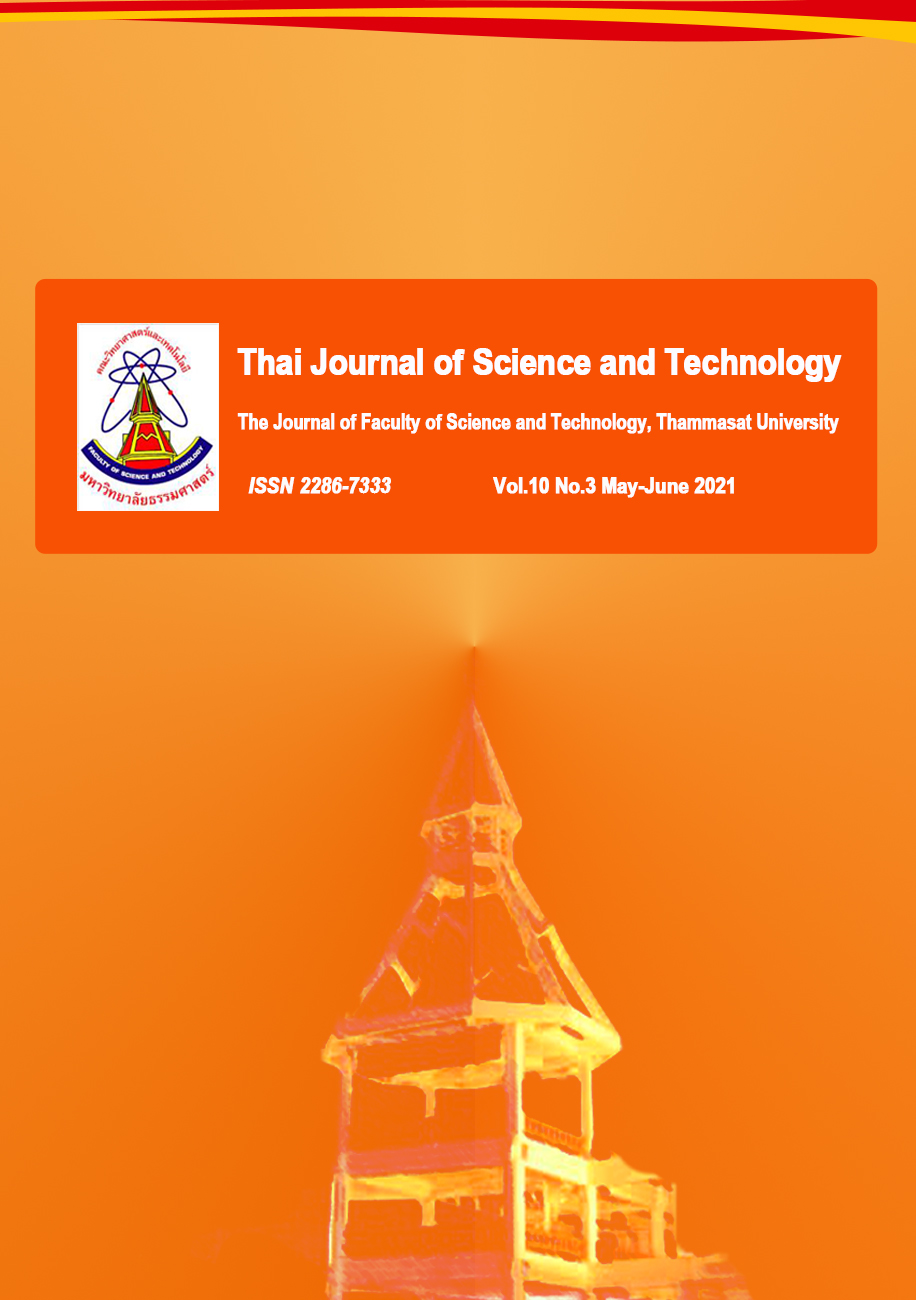Influence of Cutting Height and Plant Spacing of Leucaena for Using Machine Harvest under Sandy Saline Soil for Renewable Energy
Main Article Content
Abstract
This study aimed to determine suitable Leucaena leucocephala cutting height and plant spacing for machine harvest under sandy saline soil for renewable energy to reduce field production cost. The experimental design was split-plot in Randomized Complete Block Design with 4 replications. The main plot was 3 levels of cutting height (5,10 and 15 cm. from the ground surface). The sub plot was 4 plant spacing ((50x50)x150, (75x75)x150, 50x200 and 100x200 cm.). The results showed that there was no difference in plant height among all treatment where the average plant height at 12 months was 344.46 cm. Furthermore the cutting height did not in fluent to dry matter yield of leucaena, while the (50x50)x150 cm. plant spacing promoted the highest (p<0.05) dry matter yield at 3,308.34 kg rai-1. Next, the leucaena wood from energy treatment had similar chloride (0.18%), ash content (1.78%) and heat value (17.93 MJ kg–1) which pass the critical biomass fuel standard. Finally, the leucaena can be grown under saline soil with low cutting height and narrow double rows spacing for machine harvest.
Article Details

This work is licensed under a Creative Commons Attribution-NonCommercial-NoDerivatives 4.0 International License.
บทความที่ได้รับการตีพิมพ์เป็นลิขสิทธิ์ของคณะวิทยาศาสตร์และเทคโนโลยี มหาวิทยาลัยธรรมศาสตร์ ข้อความที่ปรากฏในแต่ละเรื่องของวารสารเล่มนี้เป็นเพียงความเห็นส่วนตัวของผู้เขียน ไม่มีความเกี่ยวข้องกับคณะวิทยาศาสตร์และเทคโนโลยี หรือคณาจารย์ท่านอื่นในมหาวิทยาลัยธรรมศาสตร์ ผู้เขียนต้องยืนยันว่าความรับผิดชอบต่อทุกข้อความที่นำเสนอไว้ในบทความของตน หากมีข้อผิดพลาดหรือความไม่ถูกต้องใด ๆ
References
Abrahamson, L.P., Volk, T.A., Kopp, R.F., White, E.H., & Ballard, J.L. (2002). Willow Biomass Producer’s Handbook. New York: State University of New York.
Bernberger, I., Brunner, T., & Barnthaler, G. (2006). Chemical Properties of Solid Biofuels- Significance and Impact. Biomass & Bioenergy, 30(11), 973-982. doi:10.1016/j.biombioe.2006.06.011
Bunyavejchewin, S. (1984). The relationship between planting distance and growth, above-ground biomass and firewood production in Leucaena leucocephala de Wit at Sakaerat, Pak thong chai, Nakhon Ratchasima. Thai Journal of Forestry, 4(3), 307-320. (http://frc.forest.ku.ac.th/frcdatabase/bulletin/fforjournal/v3n4_4.pdf) (in Thai)
Chotchutima, S. (2013). Effects of Spacing, Cutting Height and Cutting Frequency on Yield, Yield Component and Chemical Component of Leucaena (Leucaena leucocephala (Lam. ) de Wit.) for Renewable Energy. (Doctor of Philosophy’s Degree). Department of Agronomy, Faculty of Agriculture, Kasetsart University. (in Thai)
Chotchutima, S., Kangvansaichol, K., Tudsri, S., & Sripichitt, P. (2013). Effect of spacing on growth, biomass yield and quality of Leucaena (Leucaena leucocephala (Lam.) de Wit.) for renewable energy in Thailand. Journal of Sustainable Bioenergy Systems, 3, 48-56. doi:10.4236/jsbs.2013.31006
Dimitriou, I., & Rutz, D. (2015). Sustainable Short Rotation Coppice: A Handbook. Munich: WIP Renewable Energies.
Lewandowski, I., & Kicherer, A. (1997). Combustion quality of biomass: practical relevance and experiments to modify the biomass quality of Miscanthus x giganteus. European Journal of Agronomy, 6, 163-177. doi:10.1016/S1161-0301(96)02044-8
Ministry of Energy. (2011). Biomass Energy. Energy policy and planning office. Bangkok: Ministry of Energy. (in Thai)
Montes, C.S., da Silva, D.A., Garcia, R.A., de Muniz, G.I.B., & Weber, J.C. (2011). Calorific wood density and rainfall gradients in the West African Sahel. Biomass & Bioenergy, 35, 346-353. doi:10.1016/j.biombioe.2010.08.058
Nielsen, H.P., Frandsen, F.J., Dam-Johansen, K., & Baxter, L.L. (2000). The implications of chlorine-associated corrosion on the operation of biomass-fired boilers. Progress in Energy and Combustion Science, 26, 283-298. doi:10.1016/S0360-1285(00)00003-4
Philippine Council for Agriculture and Resources Research and United States National Academy of Sciences. (1977). Leucaena: Promising Forage and Tree Crop for the Tropics. Washington, D.C.: National Academy of Sciences.
Proe, M., Craig, J., & Griffiths, J. (2002). Effects of spacing, species and coppicing on leaf area, light interception and photosynthesis in short rotation forestry. Biomass & Bioenergy, 23(5), 315-326. doi:10.1016/S0961-9534(02)00060-0
Shahid, S., & Rehman, K. (2011). Soil salinity development, classification, assessment and management in irrigated agriculture. Boca Raton: CRC Press.
Sripongpakapun, K. (2011). Growth and Biomass Production of Five Varieties/Lines of Leucaena (Leucaena leucocephala (Lam.) de Wit.) after Three Years of Establishment for Sustainable Energy Application. (Master's Degree). Department of Agronomy, Faculty of Agriculture, Kasetsart University. (in Thai)
Tudsri, S., Ishii, Y., & Numaguchi, H. (2002). Yield and quality tree grass species intercropped with Leucaena leucocephala. Journal of ISSAAS, 7, 83-90.
Tudsri, S., Kangwansaichol, K., & Butnak, S. (2017). Leucaena: Sustainable Renewable Energy Crop. Nonthaburi: PS. Print Printing House. (in Thai)
Tudsri, S., Sripichitt, P., Wongsuwan, N., & Nakmanee, K. (2009). Leucaena biomass production for sustainable renewable energy. Bangkok: National Research Council of Thailand. (in Thai)
USDA. (1998). Soil Quality Indicators: pH. Retrieved from www.nrcs.usda.gov/Internet/FSE_DOCUMENTS/nrcs142p2_052208.pdf


